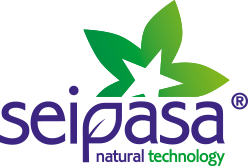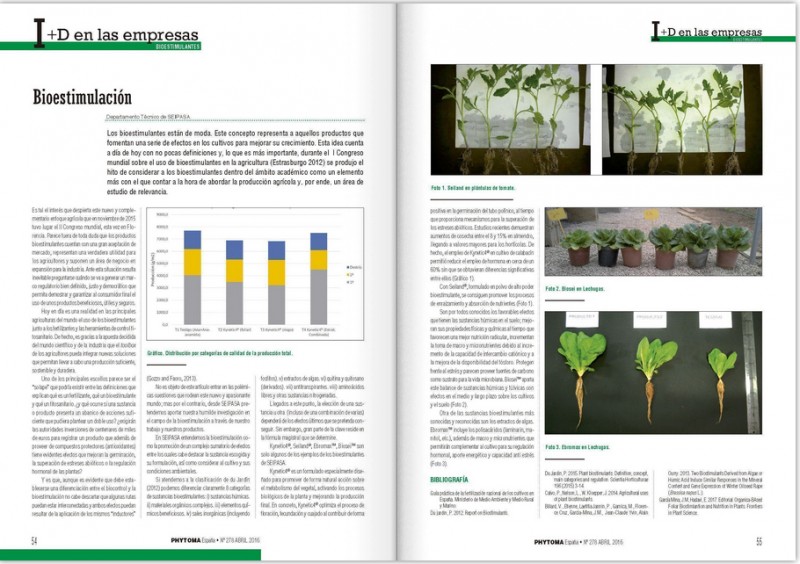Technical Department of SEIPASA
(Phytoma article: http://www.phytomadigital.com/especial-sanidad-vegetal.html#magazine/57)
Biostimulants are in fashion. This concept represents those products that promote a number of effects on crops to improve growth. Nowadays, this idea has many definitions and, more importantly, during the First World Congress on the use of biostimulants in agriculture (Strasbourg 2012) a milestone was reached by taking biostimulants into consideration within academia as another element to count on when addressing agricultural production, and thus, a relevant area of study.
Such is the interest in this new and complementary agricultural approach that in November 2015 the Second World Congress took place, this time in Florence. It seems obvious that biostimulants products have been widely accepted in the market, that they are of great value to farmers and pose a growing business area for the industry. In this situation we inevitably wonder when a well-defined, fair and democratic regulatory framework with be created to demonstrate and guarantee the final consumer that they are using beneficial, useful and safe products.
Today biostimulants are used along with fertilizers and phytosanitary control methods in the world's principal agricultures. In fact, it is thanks to the great commitment of the scientific world and industry that farmers can integrate new solutions to carry out adequate, sustainable and durable production.
One of the main obstacles seems to be the "overlap" that may exist between the definitions that explain what a fertilizer, biostimulant or phytosanitary product is. And what happens if a substance or product has a sufficient range of actions and could be used for dual purposes? Will the authorities require investments of hundreds of thousands of Euros to register a product that, in addition to providing protective compounds (antioxidants), has obvious effects that improve germination, overcoming abiotic stress or the hormonal regulation of plants?
And, although it is clear that a distinction must be made between biocontrol and biostimulation, it must not be ruled out that some routes may be interconnected and both effects might result from the application of the same "inductors" (Gozzo and Faoro, 2013).
It is not the subject of this article to get into the controversial issues surrounding this new and exciting world; on the contrary, we aim to provide our humble SEIPASA research in the field of biostimulation through our work and our products.
In SEIPASA we understand biostimulation as promoting a complex summation of effects with the chosen substance and its formulation being highlighted as well as considering the crop and environmental conditions.
Biostimulants: categories
If we look at the classification of du Jardin (2012) we can clearly differentiate 8 categories of biostimulant substances: i) humic substances. ii) complex organic materials. iii) beneficial chemicals. iv) inorganic salts (including phosphites). v) seaweed extracts. vi) chitin and chitosan (derivatives). vii) antiperspirants. viii) free amino acids and other nitrogenous substances.
At this point, the choice of one substance or another (even a combination of several) will depend on the final effect one hopes to achieve. However, part of the key lies in the master formula determined.
Kynetic4®, Seiland®, Ebromax™, Biosei™ are just some examples of biostimulants by SEIPASA.
Kynetic4® is a formulation specially designed to naturally promote action on plant metabolism, activating the biological processes of the plant and improving the final production. Specifically, Kynetic4® optimises the process of flowering, fertilization and fruit setting to contribute positively to the germination of the pollen tube, while providing mechanisms to overcome abiotic stresses. Recent studies show harvest increases between 8 and 15% in almond trees, reaching higher values for horticultural. In fact, the use of Kynetic4® in courgette cultivation reduced the use of hormone by about 60% with no significant differences between them.
With Seiland®, powder formula with a high biostimulant power, it is able to promote the process of rooting and nutrient absorption.
The favourable effects that humic substances have in the soil are well known; they improve their physical and chemical properties while improving root nutrition, increasing the intake of macro- and micronutrients due to increased cation exchange capacity and improved availability of phosphorus. They protect against stress and appear to provide carbon sources such as substrate for microbial life. Biosei™ provides this balance of humic and fulvic substances with medium and long term effects on crops and soil.
Another of the best known and recognised biostimulant substances are extracts of algae. Ebromax™ includes polysaccharides (laminarin, mannitol, etc.), in addition to macro and micronutrients that will complement the crop for their hormonal regulation, energy supply and anti stress capacity.
BIBLIOGRAPHY
A practical guide to rational fertilization of crops in Spain. Ministry of Environment and Rural and Marine Affairs.
Du jardin, P. 2012. Report on Biostimulants.
Du Jardin, P. 2015. Plant biostimulants: Definition, concept, main categories and regulation. Scientia Horticulturae 196 (2015) 3-14.
Calvo, P., Nelson, L., W. Kloepper, J. 2014. Agricultural uses of plant biostimulants.
Billard, V., Etienne, Laetitia Jannin, P., Garnica, M., Florence Cruz, Garcia-Mina, J.M., Jean-Claude Yvin, Alain Ourry. 2013. Two Biostimulants Derived from Algae or Humic Acid Induce Similar Responses in the Mineral Content and Gene Expression of Winter Oilseed Rape (Brassica napus L.).
García Mina, J.M, HAdavi, E. 2017. Editorial: Organica-BAsed Foliar Biostimlantion and Nutrition in Plants. Frontiers in Plant Science.


